Agriculture plays a vital role in virtually every aspect of our lives. Yet agriculture literacy and trust in the American food system continue to dwindle.
Everyone has an idea that comes to mind when they hear the word “agriculture.” For some, they may think of a farmer tending to cows in a pasture, whereas others may imagine a factory polluting the environment.
The sentiments people have tend to vary widely.
It is not the fault of people who grew up in urban environments being illiterate about agriculture. These consumers have basically no connection to those who are producing their food and become skeptical when they see influencers and celebrities push misinformation about GMOs or pesticides.
Younger generations and urban families are further removed from agriculture, and rapid advancements in agricultural technology made it difficult for agriculturalists to explain farm practices to the public without talking over their heads. This breakdown in communication sparked widespread skepticism about conventional American agriculture.

A 2011 survey from the U.S. Farmers & Ranchers Alliance found that over 72 percent of American consumers know nothing or very little about farming and ranching. Based on the way mainstream media and social media users talk about farmers, we have every reason to believe that the gap has widened in the past decade.
And these findings should not be all that surprising considering that less than 2 percent of Americans work on farms and ranches, and this number continues to decrease.
Celebrities and environmental activists such as Leonardo DiCaprio and Joaquin Phoenix demonize conventional farmers and label all of American agriculture as “factory farms” run by corporations. They must be unaware that 98 percent of farms are family owned and produce 86 percent of U.S. agricultural products.
This ignorance speaks volumes to the resilience of American farmers who face constant disdain and apathy about their farming practices from mainstream influencers, who are otherwise agriculturally illiterate.
The dire consequences of agriculture illiteracy can be seen in legislation like California’s Prop 12 and Oregon’s IP13. Without those of us in agriculture speaking up and taking the time to effectively educate others, the agricultural industry could be devastated.
The serious gap in agriculture literacy must be addressed to clear up misconceptions about farming and better inform consumers to be able to make educated food purchases. To restore the relationships between producers and consumers, we must utilize innovative solutions in agricultural education.

People such as Zach Johnson (aka “The Millennial Farmer” on YouTube and Instagram) have pioneered an innovative path for agricultural education by utilizing social media platforms to give a glimpse into farming for those who otherwise are completely disconnected from production agriculture. Impacts such as his have significantly pushed the needle for agriculture, but the work is yet to be finished.
One way agriculture can create meaningful dialogue with the public is to spend more resources promoting awareness of the conservation and sustainability efforts that farmers have utilized for years — ones that haven’t garnered much attention in the media.
While things like reduced tillage and cover cropping are starting to get some coverage, it will be up to agriculturalists to sacrifice their time to step in to build partnerships with consumers through open communication and positive agricultural messaging.
The most important step in bridging the gap in agriculture literacy is to not let the next generation leave grade school without knowing where their food comes from.
We must do a better job of connecting farmers and agriculturalists with primary and middle schools to establish consistent agricultural messaging that keeps open dialogue possible.
In doing this, schools can plan guest speakers and outreach programs that will provide educators with the necessary resources to feel comfortable incorporating agriculture into the curriculum.
This can be done by giving helpful insight to educators so they can create lesson plans, games, and class activities that incorporate agriculture in the classroom.

Introducing children to agriculture provides them with an experience that reveals how basic scientific procedures are applied in everyday life.
Bringing agriculture into the classroom gives students authentic learning experiences. It also provides them with the opportunity to apply concepts and ideas learned in other subjects directly into concrete examples. This could be done by including reading days with farm books, guest speakers or using farm costs as the example in math word problems.
One of the difficulties in bringing agriculture into all elementary and middle school classrooms are the schools in urban settings.
However, a solution to this problem is for 4-H and agricultural educators in local Extension offices to try to establish partnerships with these schools. By providing teachers with agricultural experts to reach out to, this can build teachers’ confidence and ultimately benefit the children.
It is a true disservice to students to incorporate STEM (Science, Technology, Engineering and Math) into the curriculum without including agricultural content.
By encouraging agricultural-based content to be included into core curriculum concepts in primary and middle schools, children can receive an enhanced education while also strengthening their agriculture literacy.
Bill Taylor grew up on a catfish farm in Alabama and received a degree in agricultural communications from Auburn University. He has since gone onto the University of Georgia for a master’s program in agricultural and environmental education.



